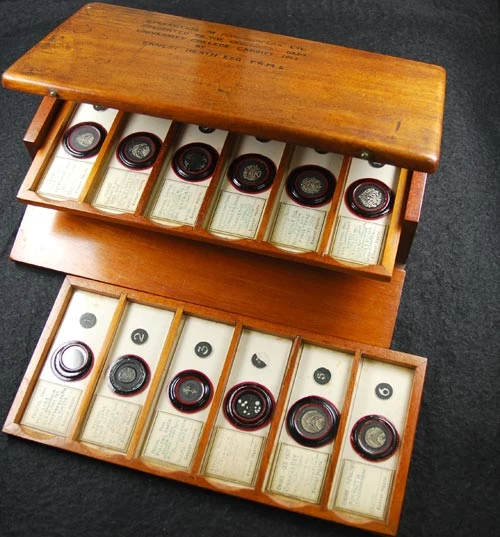Microscopic designs: Ernest Heath's collection of Foraminifera
The Ernest Heath slide collection
Would you have the patience to create tiny patterns like these?
Imagine yourself back in the early 1900's with no TV or internet for entertainment. Luckily affordable microscopes are the latest thing and you've started collecting weird and wonderful objects to look at. It's a popular form of entertainment to explore the natural world in miniature.
These wonderful microscope slides are mostly made up of foraminifera (forams), tiny animals which live floating near the sea surface or on the sea bed.
Ernest Heath: A fellow with a steady hand
The Ernest Heath slide collection
They were created by Ernest Heath, probably using a wet paintbrush to pick the shells from samples of sand and mud. We don’t know much about him, apart from that he was a fellow of the Royal Microscopical Society, somehow got hold of deep-sea mud from around the world, and must have had a lot of time on his hands! Please contact us if you know anything else about him.
Museum experts in the Geology department have recently cleaned and restored this unique collection of beautiful slides.
Fossils from the birth of a new science.
Microscope slide before and after conservation
Some of the forams were dredged by HMS Challenger on its voyage of discovery in 1872-1876. This was one of the first ocean-going scientific research expeditions and has been called the birth of oceanography, the study of the oceans. In fact we probably still know less about the ocean floor than we do about the dark side of the moon!
Click on the thumbnails below to view a selection of images from the collection
Ernest Heath's collection of Foraminifera
Heath Microfossil Collection: 80.36G.2. Foraminifera, Jurassic of Newbridge Road, Bath, Somerset
Heath Microfossil Collection: 80.36G.5. Foraminifera, Swansea Bay shore
Heath Microfossil Collection: 80.36G.6. Foraminifera, Amroth shore, Saundersfoot , Pembrokeshire
Heath Microfossil Collection: 80.36G.7. Foraminifera, Newgale sands, Haverfordwest , Pembrokeshire
Heath Microfossil Collection: 80.36G.8 Foraminifera, Bunowen and Dogs Bay, Co. Galway, Ireland
Heath Microfossil Collection: 80.36G.10. Foraminifera, Trawled off the Smalls Lighthouse, 20 miles south west of St. David's Head, Pembrokeshire
Heath Microfossil Collection: 80.36G.11. Foraminifera, trawled off Finistère, Bretagne, France
Heath Microfossil Collection: 80.36G.12. Foraminifera, Anchor mud from KUK Torpedo Boat Harpie, Capo d'Istria, Adriatic sea
Heath Microfossil Collection: 80.36G.13. Foraminifera, Anchor mud from SS Blue Jacket, Ergasteria, Greece
Heath Microfossil Collection: 80.36G.14. Foraminifera, Shallow Water, Barbados, West Indies, Carribean Sea
Heath Microfossil Collection: 80.36G.16. Foraminifera, Sounding 850 fms, 20 miles north of Colon, Panama
Heath Microfossil Collection: 80.36G.18. Foraminifera, Sounding 510 fms, 60 miles off West coast of Africa
Heath Microfossil Collection: 80.36G.20. Foraminifera, Sounding 600 fms, 12 miles off Mozambique
Heath Microfossil Collection: 80.36G.21. Foraminifera, Sounding 530 fms, 72 miles South East of Beira, Mozambique
Heath Microfossil Collection: 80.36G.22. Foraminifera, Foraminifera, Sounding 535 fms, 35 miles South East of Obiat, Somalia
Heath Microfossil Collection: 80.36G.23. Foraminifera, Sounding 39 fms, about 49 miles west of Bombay, India
Heath Microfossil Collection: 80.36G.24. Foraminifera, Sounding 40 fms, about 50 miles west of Bombay, India
Heath Microfossil Collection: 80.36G.25. Foraminifera, Foraminifera, Sounding 480 fms, about 20 degrees east of Aden, Yemen
Heath Microfossil Collection: 80.36G.26. Foraminifera, Sounding 135 fms. Challenger expedition station 185, Raine Island, Torres Strait, Queensland, Australia
Heath Microfossil Collection: 80.36G.27. Foraminifera, Sounding 1415 fms. Challenger expedition station 339, Mid-Atlantic
Heath Microfossil Collection: 80.36G.28. Foraminifera from Dredgings 624 fms, North Sea
Heath Microfossil Collection: 80.36G.29. Foraminifers from Dredgings 40 fms, Moray Firth, Scotland
Heath Microfossil Collection: 80.36G.36. Foraminifera from intertidal zone, Pwlldu, Gower, south Wales.


























Comments - (1)
This man is my Great Grandfather and i came across this while looking for the collection that was donated by Lionel Heath,Who was my Great Uncle.They worked together running the Star Patent Fuel Company,in Cardiff.
Any information about my uncles collection of model locomotives and rolling stock would be most welcome.I last saw the collection in 1976,but where is it now.?
I could right a book about this side of the family as they are fascinating.